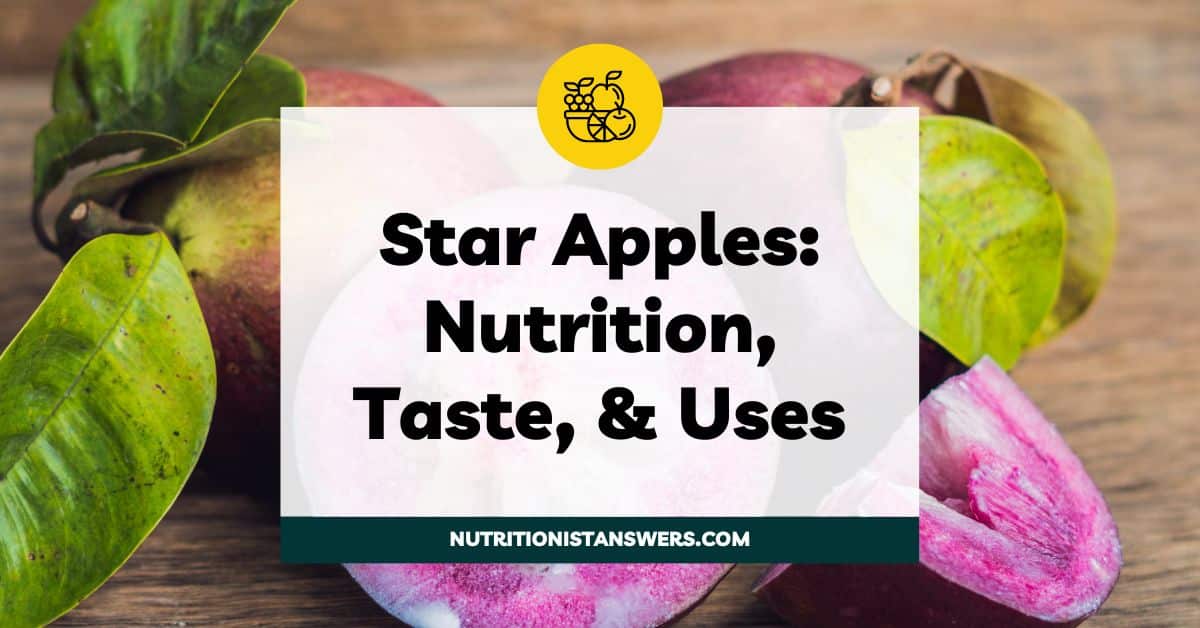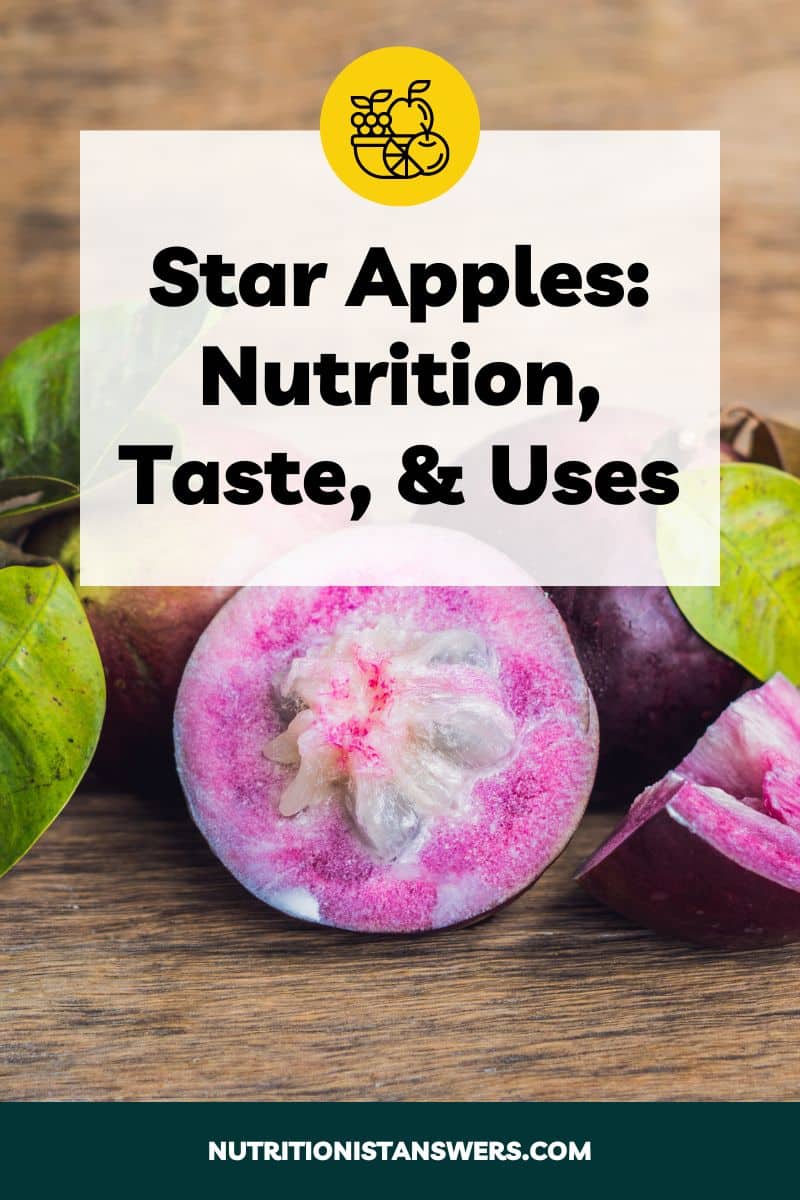Star apples are a delicious tropical fruit that you probably don’t see every day at the grocery store if you live in the United States.
If you’re lucky enough to get your hands on a star apple, you might have some questions about its nutrient content and how to store and eat it.
In this article, we’ll answer all of your questions about star apples, including where to find them, nutritional benefits, and how to use them.

What are star apples?
Star apples, also called caimito, are the fruit of the star apple tree (Chrysophyllum cainito). They are native to Central America but now grow in tropical regions throughout the world (1, 2).
Despite their name, star apples are not actually apples — they belong to the Sapotaceae family, which also includes mamey sapote, sapodilla, and miracle berries (1).
Star apples are 2-4 inches in diameter and round with a short stem and thin, leathery skin that ripens to a dark purple, bright green, or yellow color depending on the variety.
The skin is naturally filled with sticky white latex, which will begin to ooze out when cut. Latex has an unpleasant flavor and can irritate the mouth, so it’s not recommended to eat star apple skin.
When cut in half, star apples can be opened to reveal a thick rind surrounding milky white (or dark purple) flesh. In the flesh, there are 5-10 black, oval-shaped seeds arranged in a star pattern.
What do star apples taste like?
Star apple flesh tastes mildly sweet with a flavor often compared to grapes, persimmons, and rambutans. It has a soft, jelly-like consistency and can easily be scooped out with a spoon.
Star apples pair well with other fruits, such as mango, pineapple, and banana, as well as coconut milk, vanilla, and warm spices like cinnamon and nutmeg.
Star apple fruit nutrition
Star apples are low in calories and offer a moderate amount of carbohydrates, along with a small amount of fiber and protein.
Here’s a more detailed breakdown of the nutrients found in star apples:
Calories and macronutrients
We’ve included the macronutrient content for 100 grams (3.5 ounces) of star apple pulp (1):
- Calories: 67
- Carbohydrates: 15 grams
- Fiber: 2 grams
- Sugars: 9 grams
- Protein: 2 grams
- Fat: not listed
Like most fruits, star apples are rich in carbohydrates and fiber, and low in protein. We weren’t able to find information about their fat content, but it’s likely very low (less than one gram).
Vitamins and minerals
Here’s the vitamin and mineral content for star apple pulp, based on a 100-gram (3.5-ounce) serving size (1):
- Vitamin C: 9 mg (10% DV)
- Niacin: 1.1 mg (7% DV)
- Thiamin: 0.05 mg (4% DV)
- Iron: 0.6 mg (3% DV)
- Phosphorus: 19 mg (2% DV)
- Riboflavin: 0.03 mg (2% DV)
- Calcium: 12 mg (1% DV)
Star apples are a rich source of vitamin C, providing 10% of the Daily Value (DV) in a single 100-gram (3.5-ounce) serving.
They also provide smaller amounts of iron, phosphorus, calcium, and B vitamins. It’s possible that star apples contain other nutrients as well, but we weren’t able to find complete nutrition info.
Antioxidants
Star apples contain a variety of antioxidants, chemicals that protect the body from unstable molecules (called free radicals) that can damage cells (3).
Some of the main antioxidants found in star apples include quercetin, catechins, and gallic acid (4). Research shows these compounds may have anti-cancer and anti-inflammatory properties (5, 6, 7).
Where to buy star apples
Star apples are difficult to find in the United States, but you might be able to find them at farmers’ markets and specialty produce stores in southern Florida, California, and Hawaii (8, 9).
You can also purchase star apples online from Miami Fruit or Melissa’s when they’re in season, usually from January to June.
How to store star apples
Star apples should be stored at room temperature on the countertop until ripe, then transferred to the refrigerator for up to 2 weeks.
Fresh star apple pulp that has been removed from the fruit should be placed in a sealed container and will last in the fridge for up to 5 days.
It’s possible to freeze star apple pulp, but keep in mind that freezing may affect its texture. Store star apple pulp in an airtight container in the freezer — it should stay fresh for a few months.
How to eat star apples
When eating a star apple, you want to avoid the inedible skin and rind. These parts of the fruit contain natural latex that has an unpleasant taste and can irritate your mouth and throat.
To prevent latex from getting into the delicious star apple flesh, there are a few simple steps you’ll want to follow.
First, chill the star apple in the refrigerator for a couple of hours. This helps prevent the natural latex from leaking quickly out of the star apple’s skin when you cut into it.
When you’re reading to eat, use a chef’s knife to slice all the way around the star apple, only inserting the knife about a quarter of an inch.
Next, twist and pull the two halves of the star apple until they come apart. Pick out the seeds and discard them, then use a spoon to scoop out the soft white flesh (avoiding the rind) and enjoy!
Ways to use star apples
1. As a snack
Star apples are delicious served fresh on their own as a snack. They pair well with other tropical fruits, such as pineapple, mango, and banana, and are perfect for including on fruit platters.
2. In drinks and smoothies
Star apples can add a unique twist to your favorite drinks and smoothies. Their sweet, creamy flesh blends smoothly, adding a tropical touch to your beverage.
For instance, blending star apple pulp with banana, pineapple juice, and milk or yogurt creates a delightful smoothie with a balanced taste and rich texture.
Or, use it in a cocktail, blending with rum, lime juice, and a touch of simple syrup for a unique and delicious star apple daiquiri.
3. In fruit salads and parfaits
Star apples can bring a unique, tropical flavor to fruit salads and yogurt parfaits.
In Jamaica, star apples are a key ingredient in “matrimony salad”, a popular fruit salad that combines a variety of fruits with sweetened condensed milk and a pinch of nutmeg.
Star apple pulp also makes an excellent addition to parfaits, layered with granola and yogurt for a satisfying treat.
4. In frozen desserts
Star apples lend themselves wonderfully to a variety of frozen desserts, especially ice creams, custards, and sorbets.
To make star apple ice cream, simply combine milk, heavy cream, and sugar in a small pot and simmer until the sugar dissolves. Then, remove from heat, mix in pureed star apple pulp, and freeze the mixture in an ice cream maker.
For a refreshing and delightfully tangy sorbet, puree the star apple flesh and mix it with some lemon or lime juice and simple syrup before freezing.
Final thoughts
Star apples are a tasty tropical fruit with a sweet flavor, similar to grapes or persimmons, and a unique, jelly-like texture. They’re delicious on their own or added to smoothies, fruit salads, and frozen desserts.
Star apples provide a moderate amount of carbohydrates and fiber, along with 10% of the DV for vitamin C and smaller amounts of B vitamins and minerals.
Although rare in the United States, you may be able to find star apples at specialty produce stores or farmers’ markets in Florida, California, or Hawaii. Give them a try if you get the chance!
Amy Richter is a Registered Dietitian Nutritionist based in Missouri. She is an experienced nutrition writer and medical advisor for Healthline and Medical News Today. Amy is passionate about all things food-related and enjoys translating complex science into easy-to-understand articles.





